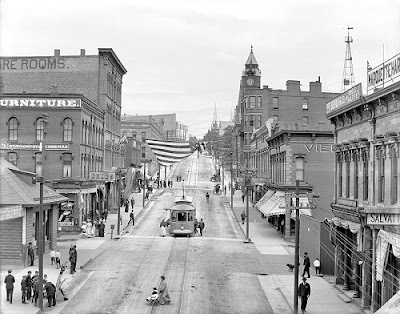The Story
of Mobility in America in the Maritime Museums of
Milwaukee
Chicago South Haven Marquette and Buffalo
Milwaukee lies along the shores and bluffs of Lake Michigan at the confluence
of three rivers: the Menomonee, the Kinnickinnic, and the Milwaukee. Ideally
situated as a port city, and as a center for collecting and distributing
produce, Milwaukee shipped more wheat than any place in the world.
The name
Milwaukee comes from an Algonquian Word meaning Good Beautiful and Pleasant
Land
The Wisconsin Marine Historical Society is a self-supported, nonprofit organization that collects, preserves,
archives and makes available to the public materials related to Great Lakes marine
history.
The Great Lakes Collection is maintained at the Milwaukee Public Library, one of the most important repositories of Great Lakes marine materials in existence. The collection contains more than 11,000 vessel files, 32,000 vessel index cards, and over 50,000 photographs and graphic images, along with books, nautical charts, manuscripts, journals, nineteenth century newspaper stories, and ship artifacts.
The Great Lakes Collection is maintained at the Milwaukee Public Library, one of the most important repositories of Great Lakes marine materials in existence. The collection contains more than 11,000 vessel files, 32,000 vessel index cards, and over 50,000 photographs and graphic images, along with books, nautical charts, manuscripts, journals, nineteenth century newspaper stories, and ship artifacts.
The Intermodal Station provides Amtrak riders access to other intercity bus operators; the
Amtrak Hiawatha line connects downtown Milwaukee and downtown Chicago daily.
Chicago is on the
southwestern shores of Lake Michigan. The Chicago Portage connects the
Mississippi River and Great Lakes Watersheds. The city's history and economy
are closely tied to its proximity to Lake Michigan. While the Chicago River
historically handled much of the region's waterborne cargo, today's lake
carriers use Lake Calumet Harbor on the South Side. When founded in 1837,
most of the early buildings were around the mouth of the Chicago River and the
original 58 blocks. Chicago’s history and development stem from its axis at the
foot of the Great Lakes.
The Story
of Chicago’s Waterways and their Impact on America’s Economy
The Chicago Maritime Museum collects items that commemorate Chicago’s maritime history.
More than 6,000 items have accumulated, including watercraft, models, articles,
books, displays, art, images and artifacts. The collection makes historic
materials accessible to scholars or anyone seeking to understand Chicago’s
unique historical connections.
Preserving
and Divulging a Community's Cultural Heritage with Local Museums
South Haven is a port city at the mouth of the Black River on the
southeastern coast of Lake Michigan and a port of call for passenger and cargo
shipping lines. In the early 1900s South Haven became a resort town because of
its recreational harbor and beaches. It is the western terminus of the
Kal-Haven Trail, popular with bicyclists and snowmobilers.
The Michigan Maritime Museum presents the rich maritime heritage of the Great Lakes and is Michigan's
most distinguished institution of maritime research, preservation and
education. Five separate buildings offer a variety of engaging opportunities:
exhibits on Michigan maritime history, a center for the teaching of boat
building and related maritime skills, and a research library. The Friends Good
Will promotes tourism in West Michigan by providing the public with a wide
variety of cultural and educational experiences. The dramatic story of this
sloop speaks to the history of commerce in the early 1800s, as well as her
pivotal role in the War of 1812.
Marquette is a major port city on Michigan’s Lake Superior, known primarily
for iron ore shipping. The land around Marquette was known to French
missionaries of the early 17th century and the trappers of the early 19th
century. The village of Marquette began on September 14, 1849, with the
formation of a second iron concern, the Marquette Iron Company. In the late
19th century, during the height of iron mining, Marquette became nationally
known as a summer haven. Visitors brought in by Great Lakes passenger
steamships filled the city's hotels and resorts. Marquette continues to be a
shipping port for hematite ores and enriched iron ore pellets, from nearby
mines and pelletizing plants.
The Marquette Maritime Museum Association began in 1980. The Museum was opened in the old City
Waterworks building in the summer of 1984. The building is a one story, stone,
Romanesque style structure. Area school kids learn their local maritime history
along with guests from all over the world.
Stannard Rock Marquette Coast Guard Station provided the support necessary for Stannard’s Rock
Lighthouse. The 110-foot sandstone tower was built on a desolate reef first
discovered in 1847. Located 44 miles due north of Marquette, its lightkeepers
called it the “loneliest place in North America” since it is the most distant
lighthouse from land on the entire continent.
The Buffalo area was inhabited before the 17th century by Native
American Iroquois tribes and later by French settlers. The city grew
significantly in the 19th and 20th centuries; immigration, the Erie
Canal, rail transport and proximity to Lake Erie fueled trade with the
midwestern part of the nation.
Buffalo is
located at the head of the Niagara River 16 miles south of Niagara Falls
The Buffalo Maritime Center promotes traditional hand skills and a craftsman-like attitude while
advancing knowledge of the Western New York maritime heritage. The high
standards of craftsmanship intrinsic to the work of boat building form the
basis of educational programs that encourage self-discipline, self-sufficiency,
and the pride of performing meaningful work.
Durham boats flat-bottomed, double-ended craft were used throughout the inland
waterways of North America to ferry supplies and people. They were used to
transport George Washington and his troops across the Delaware River during the
American Revolution and were especially common along the Niagara River to
transport salt and lumber from Little Niagara (Fort Schlosser) to Black Rock.
Durham boats eventually were replaced in the Niagara region by larger, more efficient
canal boats after the opening of the Erie Canal in 1825.














